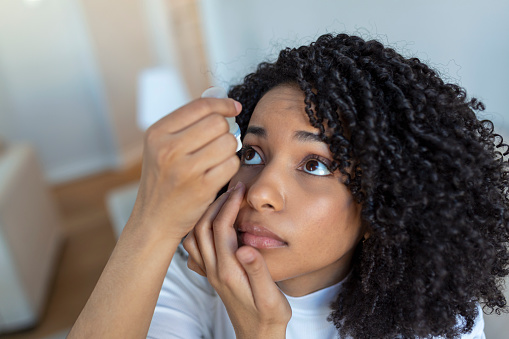Dry Eye Syndrome (DES) happens when our eyes don’t produce or maintain enough healthy tears to nourish, sustain, and lubricate them. This leaves our eyes feeling parched, causing unpleasant symptoms like itchiness, redness, and soreness.
Many people suffer from this chronic condition without realizing it can cause permanent damage to their eyes. Since DES is progressive, it’s crucial to get treatment early before symptoms worsen and harm the cornea. Without treatment or proper medication, DES often gets worse over time.
Causes
While over eighty percent (80%) of dry eye cases are due to blocked oil glands in the eyelids — a condition called meibomian gland dysfunction or evaporative dry eye — many other factors can cause this syndrome. These include:
- Gender – the majority of dry eye sufferers are women. This tends to be caused by hormonal changes, whether through the use of contraceptives, pregnancy or menopause.
- Age – there’s a higher prevalence of DES in those over 50 years of age
- Environment – dry wind, dry air and dry climates can evaporate the tears. Home and car heaters, air conditioners, fans and hair dryers also cause tears to evaporate.
- Medication – these include antidepressants, decongestants and blood pressure medications.
- Auto-immune disorders – Sjogren’s disease and arthritis, among others.
Symptoms
If you have dry eye syndrome, you may experience the following symptoms:
- Gritty, itchy, or stinging eyes
- Excessive tearing and discharge
- Eyes that feel tired or dry
- Increased light sensitivity
- Regularly using eye drops
- Discomfort that worsens as the day progresses, or after prolonged time in the sun or using electronic devices.
Treatments
Dry Eye Syndrome (DES) happens when our eyes don’t produce or maintain enough healthy tears to nourish, sustain, and lubricate them. This leaves our eyes feeling parched, causing unpleasant symptoms like itchiness, redness, and soreness.
Many people suffer from this chronic condition without realizing it can cause permanent damage to their eyes. Since DES is progressive, it’s crucial to get treatment early before symptoms worsen and harm the cornea. Without treatment or proper medication, DES often gets worse over time.
Other common treatment options include:
IPL (intense pulsed light)
IPL is an innovative treatment for dry eyes and styes. It is a non-invasive in-office treatment that uses specific wavelengths of light to reduce inflammation around the eyes. This helps the oil-producing meibomian glands to better lubricate the eyes, significantly reducing unpleasant dry eye symptoms.
During the Optilight IPL procedure, the heat from the light helps liquefy and release oils that have hardened and clogged the meibomian glands in the eyelids. This reduces blockages that cause dry eye symptoms and improves the quality of your tears.
The Optilight IPL treatment is safe and gentle, with minimal discomfort. Patients typically notice an improvement in dry eye symptoms following their first or second treatment, but monthly treatments over a period of 4 months are generally recommended for long-term success in treating both chronic dry eye syndrome and Meibomian Gland Dysfunction. The treatment is unique in that it targets the source of the problem, the blood vessels surrounding the glands, enabling them to secrete oils naturally and resume their moisturizing function, rather than just temporarily relieving symptoms.
iLUX
The iLUX® MGD Thermal Pulsation System treats meibomian gland dysfunction by delivering targeted therapy to the blocked glands. Therapeutic heat is applied to your eyelids, melting and loosening the trapped oils. Your eye doctor will then gently massage your eyelids to help the oil flow again.
Treating both eyes typically takes no more than 12 minutes. Within 4 weeks of treatment, iLUX® can significantly reduce dry eye symptoms like gritty, irritated eyes by improving meibomian gland function by up to 300%.
LipiFlow
LipiFlow is a cutting-edge technology that helps the glands naturally restart oil production for the tear film. It does this by gently applying warmth to the blocked glands, after which our eye doctors can massage away the blockage.
Sessions tend to take about 12 minutes each, and many of our patients report significant relief from their dry eye symptoms after just one treatment. For best results, our eye care team recommends you come in for a LipiFlow treatment at our eye clinic every 9 to 12 months.
BlephEx
BlephEx treatments effectively clean the eyelids of any bacterial buildup, debris, and excess oils. They are quick, non-invasive procedures.
TearLab Osmolarity System
The TearLab device measures the concentration levels in human tears to help diagnose Dry Eye Syndrome (DES) by identifying elevated tear concentration levels, which signal dry eye. TearLab is a 3-in-1 system consisting of a test card, test pen, and countertop unit. The test card is a single-use microchip that collects a tiny sample of tear fluid in under 30 seconds. It sits inside the test pen, which analyzes the sample and sends the data to the reader in the unit. The unit, which rests on a flat surface, displays the test results within seconds.
It’s important to note that not all treatment options may be available at your local Elevate Eyecare location. However, your eye doctor can determine the best option for you and refer you to a specialist or another one of our locations for your treatment plan.
